Understanding What Spurs Are Used For | Equestrian Gear
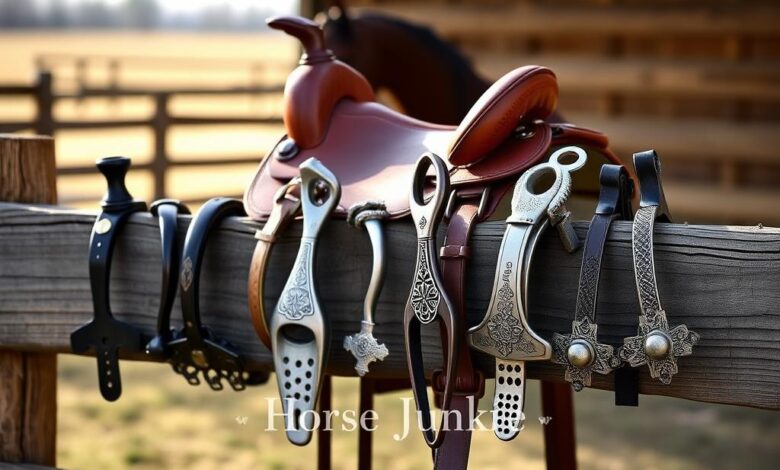
Ever thought about whether spurs really help riders and horses connect better, or if they just put pressure on the horse’s sides? This question makes us question the true purpose of spurs in riding. Let’s dive into the world of spurs to see their role in training and performance.
Knowing how spurs work is key for good riding and the horse’s health. It’s not just about how they look; it’s about their function.
Key Takeaways
- Spurs serve as a communication tool between the rider and the horse.
- Understanding the correct timing and technique is crucial in using spurs effectively.
- Incorrect use of spurs can lead to discomfort or resistance in the horse.
- Soft rowel spurs are often preferred for youth and amateur riders.
- Spurs should reinforce leg cues rather than replace them in training.
What Are Spurs in Equestrian Gear?
Spurs are key in equestrian sports, helping riders talk to their horses. Knowing what spurs are helps riders use them right. These small tools attach to the rider’s heel, giving subtle signals to the horse.
Definition of Spurs
Spurs send cues to the horse through the rider’s legs. They use gentle pressure to help the horse respond well. The way spurs are used changes with each equestrian sport, showing the different needs of riders and horses.
History of Spurs in Equestrian Sports
Spurs started as a form of art in the 15th century, with fancy designs and engravings. This made them a symbol of the rider’s status. By the 16th century, designs in northern Europe got simpler.
In the Americas, especially in Mexico and the western United States, fancy designs kept going strong. Different riding styles led to different spur designs. Western spurs were heavier and more decorated, while English spurs were sleeker.
The American Order of the Spur honors members with gold or silver spurs for their achievements. The changing designs of spurs show their lasting importance in riding. In short, spurs are more than just accessories; they have a deep history and are vital for horse and rider communication.
The Purpose of Spurs in Riding
Understanding the role of spurs in riding helps us talk better with our horses. Spurs are key in making our cues clearer, especially for tricky moves like leg yielding. They help us keep a good conversation going with our horses, making us ride better.
Enhancing Communication with the Horse
Spurs are great at sending subtle signals that help horses respond better. They make our leg cues stronger. Good communication comes from knowing when and how hard to press. Spurs help us give clear commands, making our rides smoother.
Encouraging Forward Movement
Spurs are helpful when a horse is slow to move or doesn’t want to go. They help horses move faster and more smoothly in different riding styles. It’s important to use spurs with our leg pressure. This way, horses get clear instructions without getting upset or resistant.
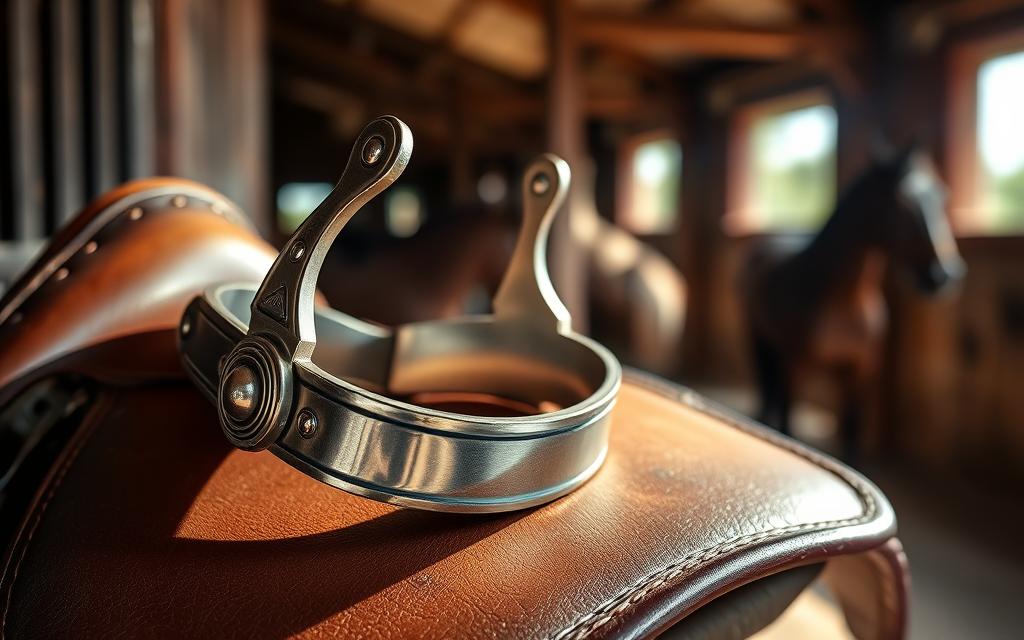
Different Types of Spurs
It’s key to know the different spurs for better horse communication. Each type is made for specific riding styles and horse needs. Spurs play a big role in how we guide our horses and make them more responsive.
Rowel Spurs
Rowel spurs have a spinning wheel at the end. They give a soft but clear signal. They’re great for horses that are easily upset, helping them move without pain.
In events like reining and roping, rowel spurs are used with longer shanks and bigger wheels. This makes the signal stronger. The size and shape of the wheel can change, helping riders find the right fit for their horse and riding style.
Blunt Spurs
Blunt spurs have smooth edges and are best for new riders or young horses. They give a gentle signal, making them safer to use. Choosing blunt spurs helps us teach our horses without being too harsh.
This shows how important it is to use spurs correctly. It helps us communicate better with our horses, making training positive for both.
No-Spur Options
For beginners or horses that are easily scared, there are no-spur options. Many riders use their legs and seat to guide their horses. This keeps the horse comfortable and sensitive.
Understanding different spurs helps us pick the right tools for training. It makes sure both the horse and rider have a good experience.
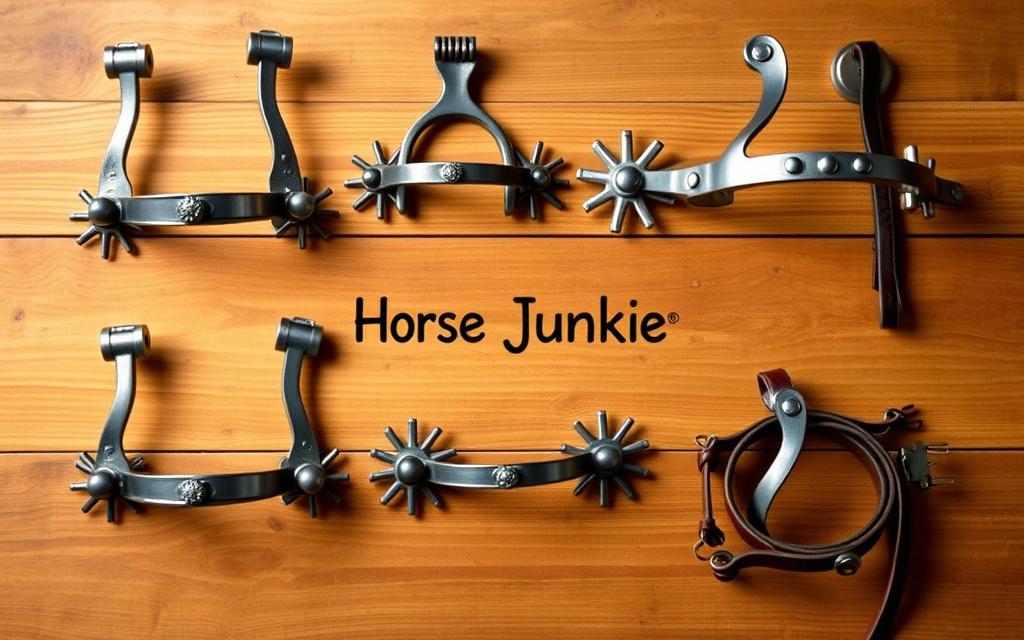
How to Choose the Right Spurs
Choosing the right spurs means knowing our riding style and the right size and fit. Each riding style has its own needs. For example, dressage riders want soft spurs for better communication. Western riders might choose spurs that give a stronger cue.
Consider Your Riding Style
Different riding styles need different spur designs. Here’s what to consider:
- Dressage Riders: Waterford style spurs with a round ball rowel and shorter shank are popular for promoting subtle movements.
- Western Riders: Typically opt for longer shanks and rotating rowels. This design helps in providing clear signals without being too harsh.
- English Riders: Favor shorter shanks, aligning with their need for precise communication in shorter stirrups.
Understanding Size and Fit
It’s important to find the right size and fit for our spurs. Here are some tips:
- The yoke of the spur should fit snugly around the heel of our boot.
- Spurs should neither be too loose nor too tight. A proper fit enhances comfort and prevents distractions for the horse.
- Western spurs often require specialized boots for the ideal fit. Ensure to wear appropriate footwear that accommodates the spur design.
- Keep in mind that larger spur straps distribute pressure more evenly and provide better stability while we ride.
- Assess the type of rowels, choosing between those with fewer teeth for quick responses and gentler options for sensitive horses.
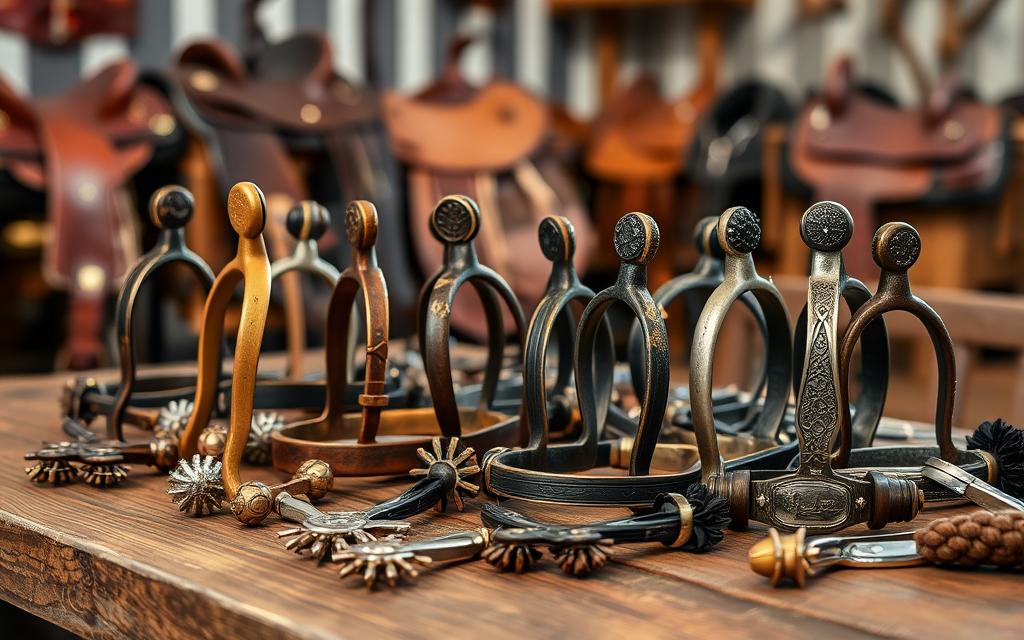
The Correct Way to Use Spurs
Learning how to use spurs right is key to a good bond with our horses. It’s all about where and when we use them. This way, we can make our rides better and get our horses to respond faster.
Proper Placement on the Boot
Where we put spurs on our boots matters a lot. They should sit just above the heel, pointing down to avoid hurting the horse. This lets us give gentle signals without hurting the horse’s sides.
Begin with short, dull spurs to avoid hurting the horse. As we get better, we can change the size and fit of the spurs to suit our needs.
Timing and Techniques for Usage
When to use spurs is very important. First, we should use our calves and heels to give light cues. Then, we can add more pressure slowly. This helps us avoid scaring the horse.
Some horses might not like spurs, especially if they’ve had bad experiences. So, we need to see how each horse reacts. Using a riding crop can be an alternative for some horses.
Good spurs techniques mean finding the right balance of pressure and comfort for the horse. We should watch for signs like tail swishing or agitation. This means we need to adjust how we use spurs.
Before using spurs, we should have a balanced seat and quiet leg aids. This helps us communicate clearly with our horses. With practice, we can use spurs without causing harm or stress.
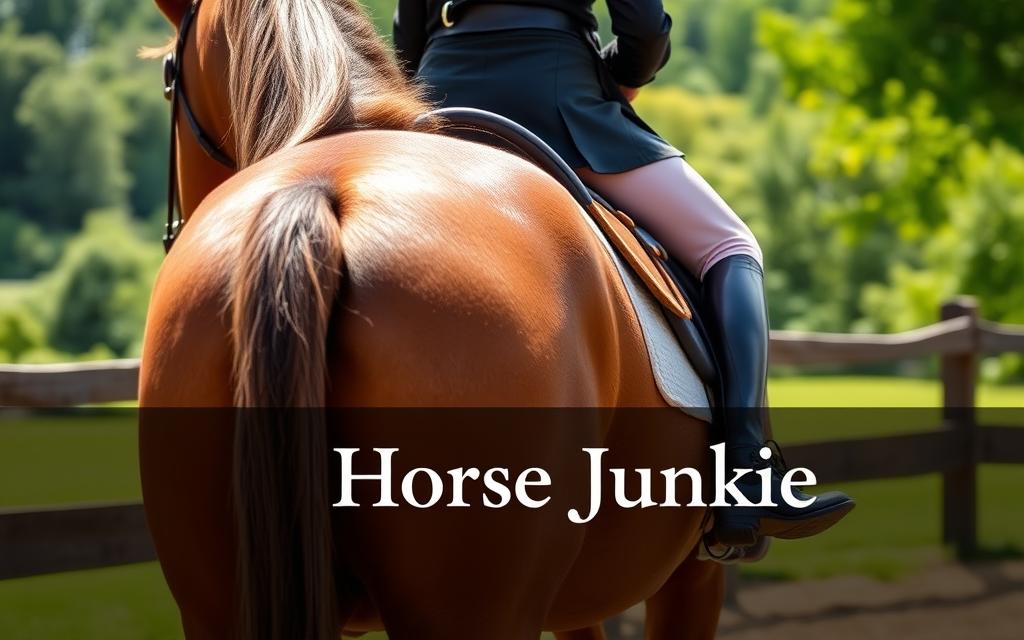
Common Misconceptions About Spurs
It’s important to clear up what spurs are really for. Many think they’re just for punishing horses. But, spurs help riders and horses communicate better. They give subtle signals that help the horse respond well, showing their importance in riding.
Spurs Are Not for Punishment
Many believe spurs are for punishing horses. But, that’s not their purpose. Spurs are meant to help riders and horses work together smoothly. Using them wrong can hurt the horse, so it’s crucial to use them correctly.
All Riders Should Use Spurs
Some think all riders need spurs to be good. But, that’s not true. Whether or not to use spurs depends on the rider’s skill and the horse’s training. Beginners should avoid spurs because they need to learn how to use them right. Knowing how to use spurs properly makes riding better for both the rider and the horse.
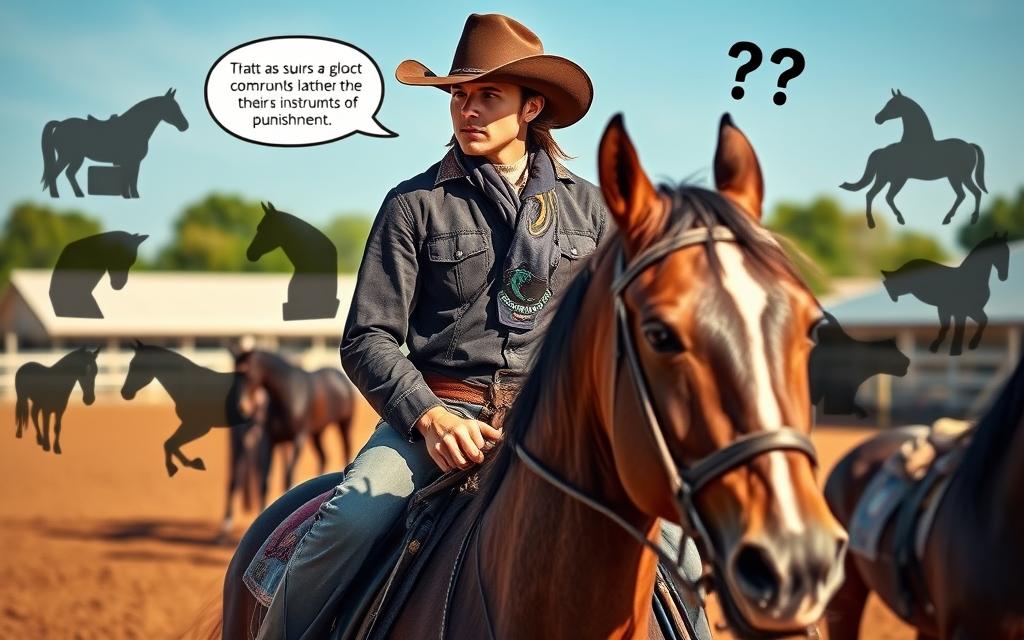
Safety Considerations
In our equestrian journey, the safety with spurs is key. It helps build a strong bond between rider and horse. We must use them right to avoid injury and keep both comfortable and confident.
Ensuring Proper Use to Prevent Injury
Always start with basic leg cues before using spurs. Knowing how sensitive your horse is helps you understand their reactions. This is especially true for green horses that are still getting used to leg pressure.
Misusing spurs can cause discomfort. This might lead to behaviors like bucking or agitation. By starting with gentle cues and using spurs only when needed, we ensure safety.
Alternatives to Spurs for Beginners
For new riders or those with inexperienced horses, there are safer options. Blunt spurs or no-spur riding are great for a gentle start. Riding crops offer another way to communicate without causing stress or discomfort.
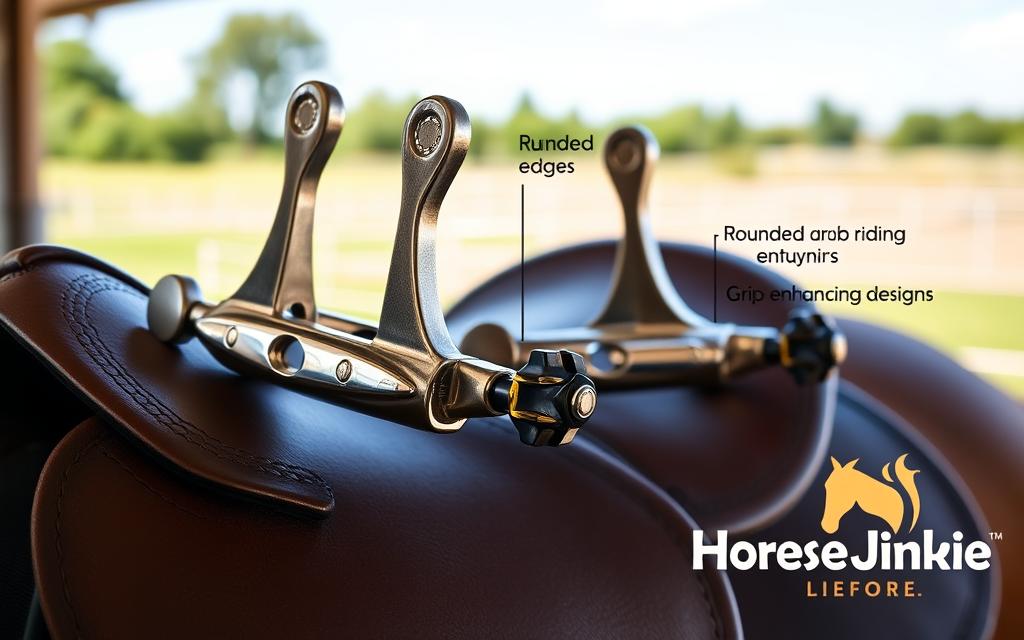
How Spurs Affect Horse Behavior
Understanding how spurs affect horse behavior is key for riders. Using spurs correctly can greatly improve a horse’s sensitivity and response to cues. This shapes how they react to different signals. By using spurs wisely, we can improve our communication with our horses, leading to a better riding experience.
Understanding Sensitivity and Responsiveness
Horses vary in sensitivity and responsiveness, just like people. Some horses respond well to subtle cues, while others need clearer signals. Knowing this helps us adjust our use of spurs to match our horse’s behavior.
Training is crucial. Horses should learn basic leg cues before spurs are introduced. This foundation is essential for a strong bond between rider and horse.
The Role of Spurs in Dressage vs. Western Riding
In dressage and western riding, spurs are used differently. Dressage riders use softer spurs for subtle cues. Western riders, on the other hand, use spurs more consistently, depending on the event.
Whether training for cutting or reining, the goal is respectful communication. We should use steady pressure, not sudden jabs. This way, spurs help the horse respond naturally, without discomfort.
Maintenance and Care of Spurs
Regular spur maintenance is key to keeping them in top shape. Proper care ensures they work well and are safe. With the right care, spurs can last for decades, showing their durability.
Cleaning Your Spurs After Use
After each ride, clean your spurs well. This prevents rust and keeps them looking good. For rowel spurs, make sure they spin freely.
A simple rinse and dry helps a lot. Use mild soap and a soft cloth to avoid scratches.
Storing Spurs Properly
Storing spurs right is important for their condition. Keep them in a dry place to avoid rust. Use a dedicated container to protect them from dust and damage.
Store leather straps in a cool, dry spot. With good care, your spurs can last over 50 years.
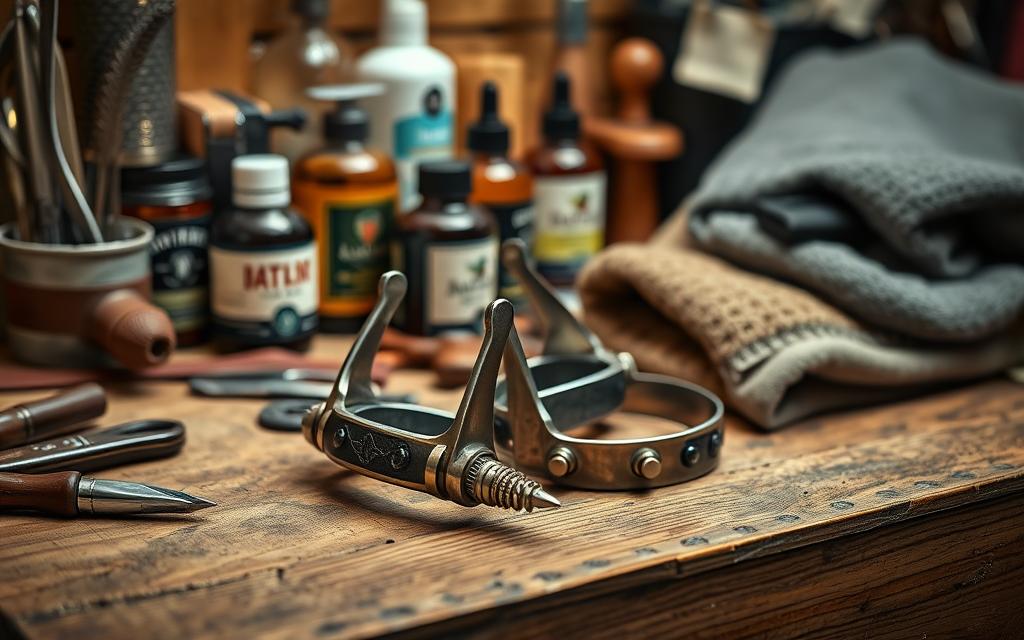
Conclusion: Spurs as a Tool for Better Riding
Spurs are key in equestrian riding, helping riders and horses communicate better. They make riding more effective and keep horses comfortable. Knowing about different spurs and their uses is important, especially in sports like barrel racing and reining.
Summary of Key Points
Using spurs wisely is important. Our experience, our horse’s sensitivity, and choosing the right spur matter a lot. For example, spurs with more rowels are gentler. English and Western spurs serve different needs.
Watching our horse’s body language helps us understand their feelings about spurs. Signs like pinned ears or swishing tails tell us a lot.
Encouragement for Responsible Use
Using spurs carefully improves our bond with horses and prevents misuse. Gentle pressure and knowing how spurs work are key. This way, we keep our relationship with horses positive.
Let’s promise to use spurs responsibly. We should think about our goals and our horses’ well-being in every ride.
FAQ
What are spurs used for in equestrian riding?
What types of spurs are available for different riding styles?
How do spurs improve a rider’s communication with the horse?
Are spurs designed for punishment?
What should beginners know about using spurs?
How do I choose the right spurs for my horse?
How can improper use of spurs affect horse behavior?
What maintenance is required for spurs?
What impact do spurs have on different riding disciplines?
Source Links
- Why and When I Introduce Spurs to My Horses
- How To Properly Use Spurs
- Are Spurs for You?
- Spur
- How to Introduce Your Horse to Spurs
- Complete Guide to Riding Spurs – Equspaddock
- Are Spurs for You?
- Horsemanship How-to: Use Spurs Properly
- The Western Spur – The Cowboy Accountant
- Spurs: An Essential Cowboy Gear Spurs are an essential piece of equipment for cowboys and horseback riders. They allow riders to com
- Western peeps – how to choose spurs?
- How to Choose the Right Set of Spurs
- Horsemanship How-to: Use Spurs Properly
- How To Use Spurs
- The Scoop on Spurs: How to Make Sure Your Spurs Fit Correctly – Quarter Horse News
- Should I Use Spurs On My Horse?
- Ode to the Spur
- The Selection and Use of Performance Horse Spurs – Quarter Horse News
- Horsemanship How-to: Use Spurs Properly
- HOW TO USE SPURS EFFECTIVELY – Gascon Horsemanship® Shop
- Hoofbeats magazine
- When and why to use…or not to use…spurs. – Official Site of Stacy Westfall
- Are Spurs for You?
- Caring for your spurs
- Bone Spur: Causes, Symptoms & Treatment | UPMC
- What Are Bone Spurs?
- Are Spurs Cruel?






